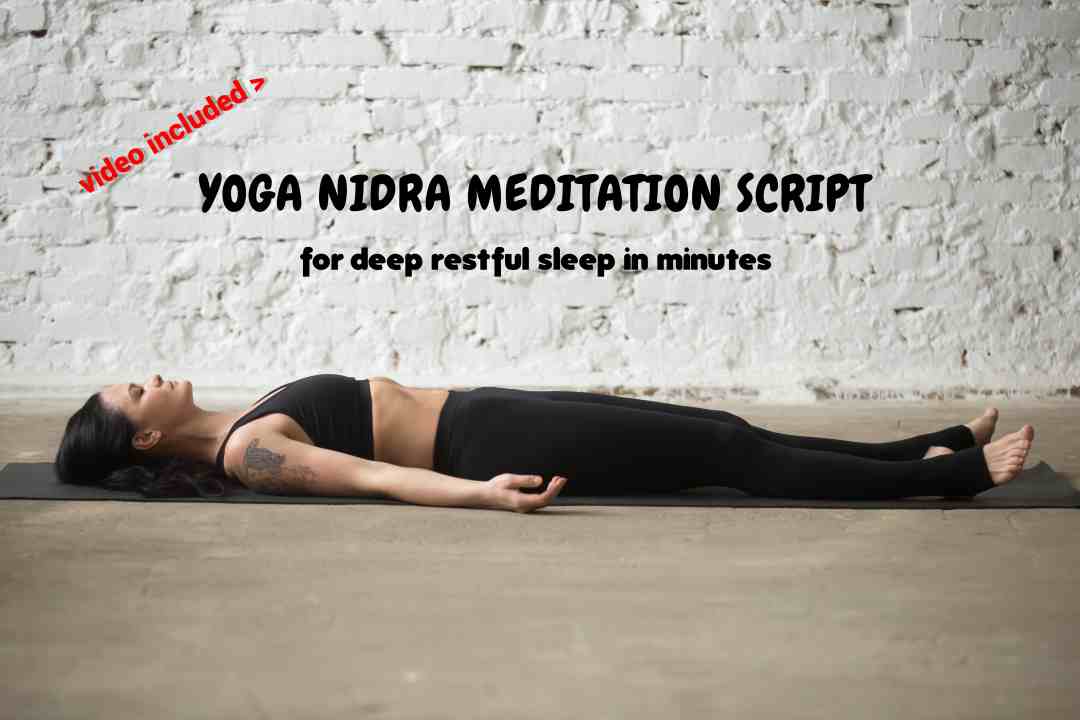What is Meditation?
A lot has been written and spoken on meditation, however you actually require a very long time to understand the true meaning of meditation. It is best to understand it as you understand sleeping. As you cannot teach ‘sleeping’ – so is ‘meditation.’ You sleep when you are in a suitable conditions to do so – proper light, bed, space, posture and a calm mind.
You all know from first hand experience – when you sleep you are unaware that you are sleeping. If you get to know you are sleeping – it means you are awake.It is exactly similar while meditating.
You aught to prepare to be in proper conditions for meditation to happen. For instance, to meditate you require – proper attitude and environment. For these two main criteria – you need to be positive, have a suitable lifestyle, assume a posture on a regular basis and apply the required techniques.
12 Step Guide to Meditation
Yoga is incomplete without meditation and vice versa. The main tool and also the outcome of Yoga is – meditation. “The classical approach to the yogic path of Yogic path of meditation is called Raja Yoga.” The techniques of meditation are handed down from ancient times through teachings. The following techniques are for beginners in meditation, although an experienced meditator will also find the guidelines helpful:
I. Location for Meditating
It is always best if you make a separate space or spot for meditation every day. Keep the place you select clean and away from any negative vibrations or distractions. When you sit down to meditate face north and east so that you are in sync with the magnetic vibrations of the earth. The sacred location or place could be simple yet beautiful to help you feel focused.
II. Time during Meditation
While meditating you need to slow down your mind of the everyday activities buzzing around you. Therefore, being regular in time, place and practice is of utmost importance. The best time for you meditate are dawn and dusk. The time most beneficial is the ‘Brahma Muhurta’ (between 4-6 am). This is so, because after sleep your mind is clear and relaxed before it gets involved in the everyday activities. However, any time is good to meditate. Moreover, make sure that you can take yourself away from the daily activities.
III. Meditation – a habit
It is best to practice meditation consistently at the same time. Because, when you sit down to meditate regularly – it helps you to develop the essential habit of focusing and detachment from daily activities. Start making the habit of meditation – by practicing for 15-20 minutes initially and then building it up to half and hour to one hour. The more you get into the habit – the more you will feel the need to meditate during the stipulated time.
In case you miss the time – do not fret – you can practice it anytime or place that suits you. Especially, for those of you who travel – continue meditating even if you are away from home. You can always find a peaceful location, in the balcony, garden, gym or near the pool in case you are staying in a hotel.
Hand Mudras or postures during Meditation
IV. Sitting Position

Always try and sit upright when you practice meditation. Your position should be steady with your spine straight yet make sure you are not tensed. Allow the psychic current to travel uninterrupted from the base of your spine to the tip of your head in order to steady your mind and hep you concentrate. Moreover, when you sit in a comfortable cross legged posture you body gets a firm base and makes the energy flow in a triangular path. This makes sure the energy is not dispersed.
When you practice asanas (postures) it will strengthen your back and enable you to sit more comfortably. The more you concentrate the more your breathing, brain waves and metabolism will slow down.
More on Breathing (Pranayama) techniques to slow down your breath and calm your mind.
V. The Breath while Meditating
We tend to breathe unconsciously since we were born. The idea is to become aware of your breath – notice it by paying attention to it so that you consciously try to breathe rhythmically in a relaxed manner.
Step 1:
Take few deep breaths by inhaling deeply and exhaling out from your abdomen – this will make the oxygen go to your brain.
Step 2:
Inhale for 3 seconds and exhale for 3 seconds. After which, slow down your breath to a pace that is not noticeable. Soon you will notice that your breath will become silent and light.
These two steps of breathing “steadies the ‘prana’ and quiets the mind.”
How Om Chanting – calms your breath and mind
VI. Mind and Meditation
Before you even begin to mediate – give your mind the command to quieten down for a certain time span and you will be amazed how your mind responds to you. Forget the past, present and future for the specific time. The mind quietens down based on how much are you committed with an genuine desire to practice meditation.
“Meditation allows us to see things as they are.”
Make a resolution every time you meditate to face reality and not waver into imagination. It will take time – and each one of you will take time according to individual awareness. Therefore, do not get impatient. Be gentle with yourself and coax your mind to focus away from thought patterns that stem from a space of fear and could be destructive. Commit to your self each day while you meditate to your well-being.
“Detachment from hopes and fears protects against suffering.”
Psychology on How to Overcome Procrastination – 6 Proven Ways
VII. Selecting a ‘Point’ of Concentration
Choose a point to focus so that the mind may rest. Your mind is habitual to daydream and get disconnected from being in the present – that is why it needs a point or an anchor to remain grounded to practice meditation.
- If you are “predominantly intellectual” you could focus on the space between your eyebrows.
- For those of you who are “emotional” you should visualize in the heart plexus.
Always keep the focus point same. In case it is difficult for you to discern if you are more emotional or intellectual – just do what naturally feels good to you and makes you feel for more strongly.
This can be discovered by trial and error. Remember, there are no hard and fast rules in meditation. It is unique for each human experience.
VIII. Selecting an ‘Object’ of Concentration
While you select an object to concentrate on – choose a neutral object or something that uplifts you. For instance , if you are taking the help on a hymn or mantra – repeat it in your mind so that you can coordinate it with your breathing. In case you are non-religious and do not have any hymn or mantra – just chant ‘Om’ or ‘Aum’.
In case you start feeling drowsy you could repeat the hymn aloud. However, always give preference to chanting silently as it is stronger. Remember, always to chant the same hymn or mantra. As a result, your mind will tune itself more easily to the sound and rhythm of the hymn.
As you repeat the hymn or mantra – you will notice gradually the hymn, the object of concentration and your breath all merge into one.
8 Ways to attract Good Energies in your Life Everyday
IX. Giving Space – to the Mind
Your mind and the thoughts in them are like a vast sky with clouds of thoughts drifting in them. It has a tendency to wander. Let them float around, however refrain yourself from giving attention to your mind. Like little pieces of paper floating around your mind and thoughts will settle down. Gradually they will cease to jump around and you will be able to concentrate along with the prana.
The object of this is to free your mind from emotional layers of agitation – if any. Most importantly, practice to be gentle yet firm with your mind. Do not try too hard – or else you may get anxious. Just let your mind be and just feel the present moment.
X. Disassociating from the Mind
Develop mindfulness and become aware of your mind as if you are separate from it. Be mindful and watch is as if you are watching a film. You become the spectator – and you are not the mind. Thus, the detachment from the mind – helps you disassociate with it and you calm down. It frees your mind of anxieties and worries like challenge of doing a task or meeting a deadline.. You can call this “stillness” in the spiritual sense.
Have you read the Book “Stillness Speaks” by Eckhart Tolle (A Spiritual Teacher)
XI. Purity of Thoughts
When you are able to concentrate for a sustained period it leads to ‘meditation’. You can describe it as “an uninterrupted flow of energy pouring oil from one vessel to another.”
When you meditate repeatedly it leads to pure thoughts. Where the thought vibration and sound vibration – both merge and the result is – no awareness of meaning.
“Vocal repetition progresses through mental repetition to telepathic language, and from there to pure thought. This is a subtle state of transcendental bliss with duality, where there remains awareness of subject and object.”
XII. Samadhi
As you practice meditation – the duality disappears and you reach the super conscious state called ‘Samadhi’. Yes, it is possible – therefore, be patient because it may take a long time to reach here.
Samadhi – means – to rest in a state of bliss, where the knower, act of knowing and knowledge – all are in one.
All religions and faiths – reach this state of being super-conscious called meditation.
Your obstacles will get removed as you create a setting conducive to meditation. Video on Meditation Tips for beginners, by Denzil Oconnell.

How Mediation will benefit you?
Meditation if practiced an hour daily will help you live life peacefully and face challenges with spiritual strength. It is one of the most powerful tonic.
While you meditate the divine energy freely flows and has a beneficial influence on your mind, body and senses. It is through meditation – your intuitive knowledge spreads and you open up to eternal bliss. Moreover, Meditation rewires your brain – and helps to calm and steady your mind.
As per recent study “meditation literally reduces the density of brain tissue associated with anxiety and worrying.”
Meditation improved focus and cognitive ability. As per a study conducted on various kinds of meditation like: Transcendental , Hindu, Tibetan, Buddhist and Sufi Meditation or Vipasana it was found that all improve focus.
Begin meditation by a 20 minutes practice each day and gradually increase it to 60 minutes. Your body could feel tremors or twitches – learn to control them and let the energy be internalized.
Related Articles and Videos:
Blog: How Meditation Alters your Brain in just two weeks
Video : 5 Medically Proven Benefits of Meditation
Video and Guide: Best time to do Sun Salutaion (Surya namaskar) in Yoga
Blog: Thankyou for the Gratefulness
Blog: Advice for Parents of University Students Leaving Home







